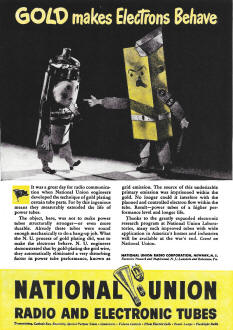|
In 1944 when this National
Union Radio Company ad appeared in Radio News magazine, the price of
gold bullion was $35 US per ounce, as established by the
Bretton-Woods
Agreement. Inflation remained near zero until 1971 when President Nixon
removed the U.S. treasury notes (dollars) from the gold standard. Take a look at
the inflation chart in the background of the RF Cafe header (top of page) to see
what has happened since then. Today's spot gold bullion price is around $1800
per ounce - a factor of 51x higher. According to the Bureau of Labor Statistics'
Inflation Calculator, $35 in 1944 had the equivalent purchasing power of
$538 today - a factor of 15x. That means the inflation-adjusted price of gold is
about 3x what it was when National Union decided to use it to plate the wire
control grid of its high power vacuum tubes in order to minimize
performance-degrading grid emissions. Because relatively little gold would have
been used, it is doubtful a 3x rise in the price would have caused them to stop
using it if the tubes were still in production today. By now, though, there is a
good chance another less expensive material and/or method would have been
developed to reduce grid emission. Regardless, the word "gold" is an attention
grabber that at least psychologically adds value to any product to which it is
applied.
Here is the October 1944 National Union
Radio Company ad.
National Union Radio and Electronic Tubes Ad
 Gold Makes Electrons Behave Gold Makes Electrons Behave
It was a great day for radio communication when National Union engineers developed
the technique of gold plating certain tube parts. For by this ingenious means they
measurably extended the life of power tubes.
The object, here, was not to make power tubes structurally stronger - or even
more durable. Already these tubes were sound enough mechanically to do a bang-up
job. What the N. U. process of gold plating did, was to make the electrons behave.
N. U. engineers demonstrated that by gold-plating the grid wire, they automatically
eliminated a very disturbing factor in power tube performance, known as grid emission.
The source of this undesirable primary emission was imprisoned within the gold.
No longer could it interfere with the planned and controlled electron flow within
the tube. Result - power tubes of a higher performance level and longer life.
Thanks to the greatly expanded electronic research program at National Union
Laboratories, many such improved tubes with wide application in America's homes
and industries will be available at the war's end. Count on National Union.
National Union Radio Corporation Newark, N.J.
Factories: Newark and Maplewood, N. J.; Lansdale and Robesonia, Pa.
Posted July 7, 2021
|










